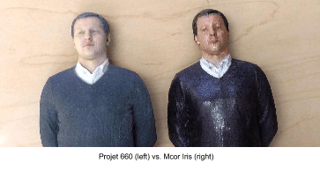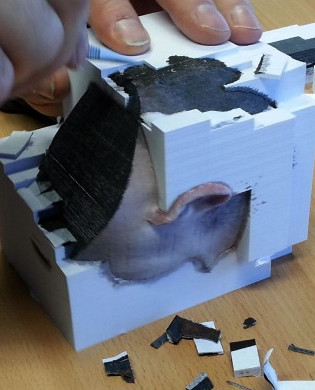 When people look at starting a 3D printed figurine business they often wonder why almost all companies use the Projet 660 even though there are other full color 3D printers on the market. Other full color 3D printers that people typically come across are the Mcor Iris, Mcor Arke, or the 3D Pandoras. While each of these other printer can produce full color 3D prints, the Projet 660 is the only printer that can produce high enough resolution 3D printed figurines in a consistent enough fashion that satisfy most end consumers.
When people look at starting a 3D printed figurine business they often wonder why almost all companies use the Projet 660 even though there are other full color 3D printers on the market. Other full color 3D printers that people typically come across are the Mcor Iris, Mcor Arke, or the 3D Pandoras. While each of these other printer can produce full color 3D prints, the Projet 660 is the only printer that can produce high enough resolution 3D printed figurines in a consistent enough fashion that satisfy most end consumers.
*Note: Scroll to the end of the article for an update on the current 3D printing technologies being used for 3D printed figurines.
Here is a quick compairson of how quality and reliability compare with the Projet 660 and the other full color 3D printers:
Resolution
Compared to the 3D Pandoras and Mcor 3D printers, the Projet 660 produces the highest resolution full color 3D prints. This is due to the ultra fine powder that is used in the Projet 660's full color 3D printing process. While the 3D Pandoras printer uses a similar printing technology as the Projet 660, the material it uses isn't nearly as fine and the software that controls it's print heads isn't as precise. 3D Pandoras prints will often seem like they have color inaccuracies in them when you compare them to the digital file. Mcor's 3D printers use an entirely different technology that involves stacking, cutting, and coloring successive layers of paper together. While Mcor's technology works very well for architectual models it isn't well suited for full color 3D printed figurines that have lots of fine detail. Here is a picture comparing the resolution of a 3D printed figurine using Mcor's technology vs. a Projet 660's:
 You will notice that the areas where there are gradients don't come out very accurately on the Mcor printer, making for a sub par 3D printed figurine.
You will notice that the areas where there are gradients don't come out very accurately on the Mcor printer, making for a sub par 3D printed figurine.
Note: When you're comparing resolution between different full color 3D printers it is extremely important that you compare the same 3D print, printed at the same size on each 3D printer. One trick that 3D printing companies use to make you believe their 3D prints are better quality is by printing them larger when they are showing them to you as samples. Larger 3D prints mean you will see more detail the 3D print since the texture of the 3D model has more room to stretch over the 3D model. Here is an example of the same resolution 3D scan printed at different 3D print sizes:

So why don’t people print larger all the time? Simple – it gets very expensive! Every time you double the height of a 3D printed figurine, the amount of material needed goes up by a factor of 8, which will 8 times your printing material costs when your fulfilling customer orders.
Reliability
While the Projet 660 is far from perfect when it comes to reliability (1 out of every 3 prints usually need to be reprinted due to a printer error), it is still much better suited to produce consistent results than the Mcor full color 3D printers. Since the 3D Pandoras printer and Projet 660 both rely on similar printing technologies you should expect similar reliability between these 2 printers. The reliablity problems with the Mcor full color 3D printer have to do with the way you post process the 3D prints (it's called "weaving"). Weaving involves taking an exacto knife to the 3D print once it's done and removing excess paper:

The difficult part about weaving, is when you're dealing with fine geometry it's very easy to accidentally remove too much paper from the model. In many cases you may need to glue the model back together or start again and reprint the model. For the Projet 660, all you need to do is use an air compressor to blow away excess material:

Powder based full color 3D printing technologies are much better suited for models with fine geometry.
Conclusion
Although the Projet 660 is the only full color 3D printer that people use for 3D printed figurines, it is likely that in the next few years there will be more ways to print full color 3D printed figurines. For now, most 3D printed figurine companies outsource there 3D printing to other companies. The reason for this, is that the current full color 3D printing technology requires too much hands on management and is too error prone for most people to handle. For all of Twindom's customers we offer direct shipping of 3D printed figurines to customers at prices that are up to 75% cheaper than other 3D printing companies:
Update since original posting
Since the original posting of this blog post there have been many advances in 3D printing (shoes are now being 3D printed), but the full color 3D printing technology has largely remained the same until the last 6-12 months. The Projet 660 was the dominant leader for full color 3D printed figurines until it recently was unseated by the HP 580 and Mimaki 553 for the production of 3D portraits. These new 3D printers have higher color accuracy, similar material cost, and much higher part durability: all key ingredients for 3D printed figurines to be a mass market product.

